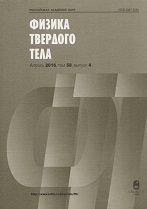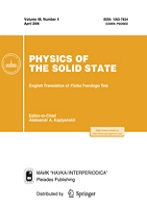|
Superconductivity
Mechanisms of interaction of YBa2Cu3Oy with water vapor at low-temperature annealing
I. B. Bobylev, N. A. Zyuzeva
Institute of Metal Physics, Ural Division of the Russian Academy of Sciences, Ekaterinburg
Abstract:
The interaction of YBa2Cu3Oy (123) with water vapor at temperatures T⩽ 150∘ has been studied. It has been shown that, with an increase in temperature, the mechanism of its interaction with water changes. Near room temperature, the main process is hydrolytic decomposition. At T∼ 100∘C, the absorption of water is significantly reduced, because the role of hydrolysis becomes less important and water penetrates the structure weakly and is incorporated into oxygen vacancies mainly in the form of OH–-groups, which leads to the transition of YBa2Cu3Oy from the tetragonal to orthorhombic phase. With an increase in temperature to 150∘C, the absorption of water increases again. In this case, the main mechanism is the penetration of water to the 123 structure, which leads to splitting of Cu–O chains and a phase transition from the 123 to pseudo-124 structure. The role of different mechanisms of interaction with water essentially depends on the oxygen content in the 123 structure. At a low oxygen index (y = 6.3), the role of hydrolysis is more important, and, at y⩾ 6.5, the incorporation of water into the structure prevails. It has been revealed that, at T = 150∘C, after absorption of water, YBa2Cu3O6.96 becomes a proton conductor.
Keywords:
Water Absorption, Oxygen Content, Oxygen Index, High Oxygen Content, Magnetic Suscep.
Received: 23.06.2015
Citation:
I. B. Bobylev, N. A. Zyuzeva, “Mechanisms of interaction of YBa2Cu3Oy with water vapor at low-temperature annealing”, Fizika Tverdogo Tela, 58:2 (2016), 225–230; Phys. Solid State, 58:2 (2016), 230–235
Linking options:
https://www.mathnet.ru/eng/ftt10066 https://www.mathnet.ru/eng/ftt/v58/i2/p225
|


| Statistics & downloads: |
| Abstract page: | 40 | | Full-text PDF : | 14 |
|





 Contact us:
Contact us: Terms of Use
Terms of Use
 Registration to the website
Registration to the website Logotypes
Logotypes









 Citation in format
Citation in format 